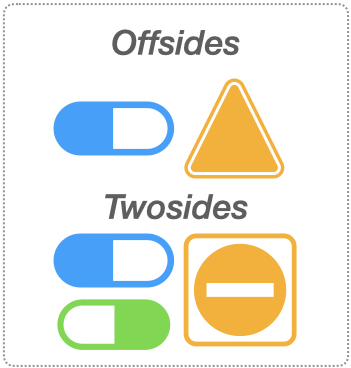Offsides and Twosides: Key resources to access adverse drug reactions (ADRs) and drug-drug interactions (DDIs) data

Importance of understanding adverse drug reactions
Adverse drug reaction (ADR) is an undesirable response caused by a drug at doses typically used in humans. Similarly, two or more drugs interacting to alter the effectiveness or toxicity are commonly called drug-drug interactions. Adverse drug reactions cause significant morbidity and mortality to patients and an unnecessary financial burden to the healthcare system. Health care practitioners and institutions must be diligent in monitoring or avoiding such interactions. Clinicians can report ADRs through the FDA's Adverse Event Reporting System (FAERS) or the pharmaceutical companies' pharmacovigilance site. However, not all adverse drug reactions are reported and are one of the primary motivations to develop two complementary databases: Offsides and Twosides. Offside is a comprehensive database of drug effects, and Twosides is a database of drug-drug interaction side effects.
Content and approach to build databases
Offsides uses publicly available clinical trial data and uses a novel statistical model to remove confounding factors like sampling variance and reporting biases. Authors validated identified drug-adverse reaction pairs identified with the new statistical approach for the capability to predict known drug targets and drug indications. Offsides contain 438,801 drug-adverse reactions "off-label" side effects, including interactions between 1332 drugs and 10,097 adverse events. Similarly, twosides include 868,221 significant associations between 59,220 pairs of drugs and 1301 adverse events. Researchers and practitioners often use these databases in conjunction with other online resources. The database and approach suggested by the authors also help identify a novel drug-drug interaction between serotonin reuptake inhibitors and thiazides that causes prolongation of QT intervals.
Availability
Currently, the database is available to the community as two comma-separated files. The Offsides database file contains human-readable names and identifiers for drugs and adverse drug reactions (RxNORM and MEDRA, respectively) with a significance score as proportion reporting ratio (PRR). Similarly, the Twosides database has names and identifiers for two drugs responsible for drug-drug interaction, identifier, and name for the adverse reaction that interaction may cause and significance score.
Conclusions
Offsides and Twosides were constructed using a different statistical model and may prove valuable in identifying comprehensive adverse drug reactions caused by a pharmaceutical agent. A web interface that helps easy navigation of collected data will significantly contribute to the scientific community.